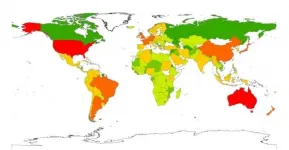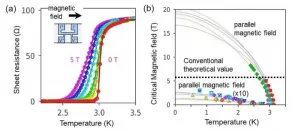(Press-News.org) Humans are creating or exacerbating the environmental conditions that could lead to further pandemics, new University of Sydney research finds.
Modelling from the Sydney School of Veterinary Science suggests pressure on ecosystems, climate change and economic development are key factors associated with the diversification of pathogens (disease-causing agents, like viruses and bacteria). This has potential to lead to disease outbreaks.
The research, by Dr Balbir B Singh, Professor Michael Ward, and Associate Professor Navneet Dhand, is published in the international journal, Transboundary and Emerging Diseases.
They found a greater diversity of zoonotic diseases (diseases transmitted between animals and humans) in higher income countries with larger land areas, more dense human populations, and greater forest coverage.
The study also confirms increasing population growth and density are major drivers in the emergence of zoonotic diseases. The global human population has increased from about 1.6 billion in 1900 to about 7.8 billion today, putting pressure on ecosystems.
Associate Professor Dhand said: "As the human population increases, so does the demand for housing. To meet this demand, humans are encroaching on wild habitats. This increases interactions between wildlife, domestic animals and human beings which increases the potential for bugs to jump from animals to humans."
"To date, such disease models have been limited, and we continue to be frustrated in understanding why diseases continue to emerge," said Professor Ward, an infectious diseases expert.
"This information can help inform disease mitigation and may prevent the next COVID-19."
Other zoonotic diseases that have recently devastated human populations include SARS, avian (H5N1) and swine (H1N1) flu, Ebola and Nipah - a bat-borne virus.
Factors predicting disease
The researchers discovered country-level factors predicting three categories of disease: zoonotic, emerging (newly discovered diseases, or those diseases that have increased in occurrence or occurred in new locations), and human.
Zoonotic diseases: land area, human population density, and area of forest. Areas with high zoonotic disease diversity include Europe, North America, Latin America, Australia, and China.
Emerging diseases: land area, human population density and the human development index. Areas with high emerging disease diversity include Europe, North America,
Human diseases: high per capita health expenditure, mean annual temperature, land area, human population density, human development index and rainfall. Areas with high human disease diversity include North America, Latin America, China and India.
"Countries within a longitude of -50 to -100 like Brazil, developed countries like United States and dense countries such as India were predicted to have a greater diversity of emerging diseases," Professor Ward said.
The researchers also noted weather variables, such as temperature and rainfall, could influence the diversity of human diseases. At warmer temperatures, there tend to be more emerging pathogens.
The analyses demonstrate that weather variables (temperature and
rainfall) have the potential to influence pathogen diversity
These factors combined confirm human development - including human-influenced climate change - not only damages our environment but is responsible for the emergence of infectious diseases, such as COVID-19.
Using data to help prevent outbreaks
"Our analysis suggests sustainable development is not only critical to maintaining ecosystems and slowing climate change; it can inform disease control, mitigation, or prevention," Professor Ward said.
"Due to our use of national-level data, all countries could use these models to inform their public health policies and planning for future potential pandemics."
INFORMATION:
Methodology: The authors used 13,892 unique pathogen-country combinations and 49 socioeconomic and environmental variables to develop this model. Information from 190 countries was analysed using statistical models to identify drivers for emerging and zoonotic diseases.
Declaration: The authors would like to thank the Australian Government's Department of Education and Training for awarding a 2018 Endeavour Research Fellowship to the primary author of this research.
The authors acknowledge the data relied for this research is incomplete. Reasons include underreporting of some previously known and undiscovered pathogens, particularly in less developed countries. For some of the predictor variables, the latest data available had missing values because recent data had not been updated.
Superconductivity is known to be easily destroyed by strong magnetic fields. NIMS, Osaka University and Hokkaido University have jointly discovered that a superconductor with atomic-scale thickness can retain its superconductivity even when a strong magnetic field is applied to it. The team has also identified a new mechanism behind this phenomenon. These results may facilitate the development of superconducting materials resistant to magnetic fields and topological superconductors composed of superconducting and magnetic materials.
Superconductivity has been used in various technologies, such as magnetic resonance imaging (MRI) and ...
Sumitomo Rubber Industries, Ltd (SRI) and Tohoku University teamed up to increase the speed of 4-Dimensional Computed Tomography (4D-CT) a thousand-fold, making it possible to observe rubber failure in tires in real-time.
This breakthrough will accelerate the development of new tire materials to provide super wear resistance, greater environmental friendliness, and longer service life. It will also aid significantly in the advancement of smart tires.
SRI initially developed 4D-CT as part of the ADVANCED 4D NANO DESIGN, a new materials development technology unveiled in 2015 that enables highly accurate analysis and simulation of the rubber's internal structure from the micro to nanoscale. This analysis ultimately ...
An evolutionary mystery that had eluded molecular biologists for decades may never have been solved if it weren't for the COVID-19 pandemic.
"Being stuck at home was a blessing in disguise, as there were no experiments that could be done. We just had our computers and lots of time," says Professor Paul Curmi, a structural biologist and molecular biophysicist with UNSW Sydney.
Prof. Curmi is referring to research published this month in Nature Communications that details the painstaking unravelling and reconstruction of a key protein in a single-celled, photosynthetic organism called a cryptophyte, a type of algae that evolved over a billion years ago.
Up until now, how cryptophytes acquired the proteins ...
About 61% of Americans have had at least one Adverse Childhood Experience (ACE), experts' formal term for a traumatic childhood event.
ACEs--which may include abuse, neglect and severe household dysfunction--often lead to psychological and social struggles that reach into adulthood, making ACEs a major public health challenge. But the long-term consequences of ACEs are just beginning to be understood in detail. To fill in the picture, two recent BYU studies analyzed how ACEs shape adolescents' delinquent behaviors as well as fathers' parenting approaches.
ACEs ...
An international survey that included 600 smokers in the UK has found that cessation messaging focused on easing the burden on our health system is most effective in encouraging people to quit.
The research, which was conducted in April-May 2020, randomly assigned participants to view one of four quit smoking messages, two of which explicitly referenced health implications and COVID-19, one referred more vaguely to risk of chest infection, and one highlighted financial motivations for quitting.
"We wanted to explore the effectiveness of smoking cessation messaging at a time when health systems the world over are beleaguered, and all our ...
Replacing regular common salt consumed by hypertensive patients in rural areas with a salt substitute can have a significant impact in terms of lowering their blood pressure, a new study by The George Institute for Global Health has revealed.
Researchers found that substituting a small part of the sodium in salt with potassium without altering the taste led to a substantial reduction in systolic blood pressure in these patients, supporting salt substitution as an effective, low-cost intervention for lowering blood pressure in rural India.
The study entitled "Effects of reduced-sodium added-potassium salt substitute on blood pressure in rural Indian hypertensive patients: a randomized, double-blind, controlled trial" provides the first-of-its-kind evidence from ...
In a new study published in the Cell Research, Chen-Yu Zhang's group at Nanjing University reports "In vivo self-assembled small RNA is the new generation of RNAi therapeutics".
The development of RNAi therapy has undergone two major stages, direct injection of synthetic siRNAs and delivery with artificial vehicles; both have not realized the full therapeutic potential of RNAi in clinic. In this study, Chen-Yu Zhang's group reprogram host liver with genetic circuits to direct the synthesis and self-assembly of siRNAs into secretory exosomes. In vivo assembled siRNAs are systematically distributed to multiple tissues or targeted to specific tissues (e.g., brain), inducing potent target gene silencing in these tissues. The therapeutic value of this strategy is demonstrated ...
A team of researchers from Graz University of Technology, Know-Center GmbH, Johannes Kepler University Linz, University of Innsbruck, Austria and University of Utrecht, the Netherlands, compared how accurate algorithm-generated music recommendations were for mainstream and non-mainstream music listeners. They used a dataset containing the listening histories of 4,148 users of the music streaming platform Last.fm who either listened to mostly non-mainstream music or mostly mainstream music (2,074 users in each group). Based on the artists music users' listened to most frequently, the authors used a computational model to predict how likely music users were to like the music recommended ...
Failure to comply with international exposure recommendations for air pollution, noise, heat and access to green space is associated with more than 1,000 deaths per year in Barcelona and more than 900 in Madrid, accounting for 7% and 3% of overall premature mortality, respectively.
This is the conclusion of a new study by the Barcelona Institute for Global Health (ISGlobal), a centre supported by the "la Caixa" Foundation. This study is the first to estimate premature mortality impacts and the distribution by socioeconomic status of multiple environmental exposures related to urban planning and transport in the two cities.
Today, more than half of the ...
Tsukuba, Japan - Although the heart beats autonomously, its function can be regulated by the brain in response to, for instance, stressful events. In a new study, researchers from the University of Tsukuba discovered a novel mechanism by which a specific part of the brain, the lateral habenula (LHb), regulates the cardiovascular system.
The cardiovascular system, specifically the heart and blood vessels, have a certain autonomy that allows them to function independently from the brain. In order for the individual to adapt to new, potentially threatening situations, the brain does have some regulatory power over the cardiovascular ...





